

|
Line connections |
|
|
|
1 |
Primary inlet (cold flow, inside tubes) |
|
|
2 |
Primary outlet (cold flow, inside tubes) |
|
|
3 |
Secondary inlet (hot flow, outside tubes) |
|
|
4 |
Secondary outlet (hot flow, outside tubes) |
|
|
5 |
Control inlet for KAN - Design Heat Transfer Capability (as H) |
|
General User Input Values Characteristic Lines Physics Used Displays Example
Module 27 is a multi-purpose component, which can work alternately as after-cooler or as general heat exchanger. See the table of specifications for a list of valid combinations.
The choice of combination must take into consideration that the secondary side is the hot one, which means the heat flows from the secondary side to the primary side.
In the design case it must be specified, in what way the component will be used (as after-cooler or as general heat exchanger). Moreover, the terminal temperature difference (upper or lower) is also to be specified (see HeatExchanger,General Notes ). Alternatively, it is also possible to avoid the definition of internal terminal temperature difference or the temperature and, instead, externally specify three of the four temperatures at the inlets and the outlets. In all cases, the result of the design calculation is the nominal value for k*A, KAN.
In the off-design mode then, an off-design k*A is then calculated from this KAN by using the physical laws. An option, an adaption polynomial or a Kernel expression (in addition or as replacement) can also be defined for the off-design scaling.
Alternatively, there are two identification modes: T2-default and T4-default. In these modes, one does not work with KAN and the corresponding scaling laws, but instead calculates k*A in such a way that the desired temperature results.
Radiation losses can be entered as loss factor.
For this heat exchanger it is possible, to specify the pressure externally (P2, P4).
It is also possible to use the flag FVOL to determine whether the off-design calculation of the pressure drop shall consider only the mass-flow (approximation for incompressible fluids) or mass
and volume flow.
Logic inlet (Connection point 5) for controlling component properties
(see also : Editing components --> Ports)
To make component properties like efficiencies or heat transfer coefficients (variation quantity) accessible from the outside (for control or reconciliation) it is possible to place the respective value on an auxiliary line as an indexed measured value (specification value FIND). In the component, the same index must then be entered as specification value IPS.
It is also possible to place this value on a logic line that is directly connected to the component (please see FVALKA=2, Variation variable: KAN, Dimension: Enthalpy).
The advantage is that the allocation is graphically visible, and errors (e.g. when copying) are thus avoided.
Pinch point violations in the case of heat exchangers: (see HeatExchanger,GeneralNotes )
Up to release 10.0, a pinchpoint violation was only determined subsequently in partial load, i.e. KA was calculated for the respective load case and from this the transferred heat quantity and then it was checked whether this heat quantity can be transferred at all at the correct temperature level. Since in the case of evaporation or condensation the temperature remains constant despite heat input or heat removal, there are cases where heat transfer is not physically possible despite the overall balance being correct. In this case, an error message was issued in Ebsilon.
The calculation has now been changed in such a way that the transferred heat quantity is reduced as far as it is still physically possible, with the minimum pinch point
can be set in a default value PINPMIN. This results in a correspondingly reduced KA.
The user is informed of this by a warning message ("KA reduced to avoid pinchpoint violation") and can then adjust the part-load characteristic curve or the part-load exponent for KA accordingly so that the warning no longer occurs. The advantage, however, is that one gets a physically possible result in any case.
Furthermore, at the end of the calculation there is a check if there is a pinch point violation due to curved course of Q(T) (caused by significant changes of cp depending on the temperature). This can be verified by dividing the heat exchanger into individual sections.
This case can occur, for example, when on the hot side the cp at the inlet is significantly smaller than at the outlet (for example, steam that has a cp of about 2 kJ/kgK at high superheat, but more than 5 just above the boiling line). This means that this steam provides more heat at a lower temperature level than at a high one. At appropriately low degrees, this can be a limitation on the amount of heat transfer that is possible.
The QT diagrams take into account the non-linearity (curvature of the curves) in areas without phase change.
The flag FSPEC (deprecated) has been divided into three flags:
Note:
When loading a model that was created with Release 11 (or older), the corresponding values for FTYPHX, FSPECD, and FIDENT are determined from the value of the flag FSPEC, and FSPEC is set to “void” (-999). The model then calculates the same result values. If required, however, the flag FSPEC can still be used as well. This is necessary so that the existing EbsScripts in which a switchover of FSPEC into an identification mode is carried out will continue working. If FSPEC is not “empty” (-999) but has a value of -4 or -5 (the old values for the identification modes),
the new flag FIDENT will be ignored, and the component will behave according to the setting of FSPEC (this is indicated in a comment).
To remove ambiguity, the terms “primary side” and “secondary side” respectively have been replaced by “cold side” and “warm side” in the input screens. The cold side is the flow from
Pin 1 to Pin 2 that is heated. The warm side is the flow from Pin 3 to Pin 4 that gives off the heat.
Design in the Case of Concurrent Flow (see HeatExchanger,General )
In the heat exchanger (Components 27) it is possible to carry out a design via the upper and lower terminal temperature difference also in the case of concurrent flow (FFLOW=1).
If both inlet temperatures are specified, the upper terminal temperature difference can only be determined iteratively. Usually this is no problem. If convergence problems occur in more
complex models, another design mode will have to be used.
Effectiveness Method
See Heat Exchangers General Information Effectiveness Method
Flag FDQLR
It is possible, you can use the FDQLR flag to define how DQLR (factor for modeling heat losses) should be interpreted.
Specific heat capacity : CP12 / CP34
The mean specific heat capacity is displayed as a result value on the cold side (CP12) and on the hot side (CP34).
The mean specific heat capacity results from the quotient of the enthalpy difference and the temperature difference.
If no temperature difference is present (e.g. in the two-phase range or when the heat exchanger is shut off), however, it is not possible to calculate this quotient. In this case, the specific heat capacity at the respective temperature is used, provided that it is defined. Otherwise the result value will remain blank.
Performance factor RPFHX
The quotient from the current value for k*A (result value KA) and the k*A expected in the respective load point due to the component physics and characteristic lines respectively (result value KACL) serves to assess the condition of a heat exchanger.
The quotient KA / KACL is displayed as a result value RPFHX.
For more information on general notes applicable to most common heat exchangers, see Heat Exchanger General Notes
For more information on how this heat exchangers compares to other heat exchangers, see Heat Exchanger General Components
|
FTYPHX |
Type of heat exchanger Like in Parent Profile (Sub Profile option only) Expression = 0: General heat exchanger |
|
FSPECD |
Design specification method Like in Parent Profile (Sub Profile option only) Expression = 0: Specification of the effectiveness (ratio of transferred heat to the theoretical maximum at infinite transfer surface) in the specification value EFF |
|
FIDENT |
Activation of a component identification mode (only in part load) (FIDENT serves to activate a component identification mode, i.e. the respective condition of the component is determined on the basis of temperature specifications) Like in Parent Profile (Sub Profile option only) Expression = 0: No identification mode In the design case, variant FIDENT=2 is identical with FSPECD=5 and FIDENT=4 with FSPECD=4. In order to prevent contradictory specifications, the flag FIDENT is therefore only used in off-design for this component. Please note: the peculiarity for these components is that in the design case identification (namely the calculation of KAN from temperature specifications) takes place by default. |
|
DTN |
Terminal temperature difference (nominal,s. FSPEC) |
|
EFF |
Effectiveness |
|
FDP12N |
Pressure drop handling line 1 to 2 Like in Parent Profile (Sub Profile option only) Expression =1: Calculated by DP12N |
|
DP12N |
Cold side pressure drop from line 1 to 2 (nominal) |
|
FDP34N |
Pressure drop handling line 3 to 4 Like in Parent Profile (Sub Profile option only) Expression =1: Calculated by DP12N |
|
DP34N |
Hot side pressure drop from line 3 to 4 (nominal) |
|
FVOL |
Flag for partload pressure drop Like in Parent Profile (Sub Profile option only) Expression =0: Only depending on mass flow =1: Depending on mass- and volume flow |
|
FDQLR |
Heat loss handling Like in Parent Profile (Sub Profile option only) Expression =0: Constant (DQLR*QN in all load cases) |
|
DQLR |
Heat loss through radiation (relative)
|
|
TOL |
Maximum permissible tolerance in energy balance for the internal iteration |
|
FMODE |
Flag for the calculation mode design/off-design Like in Parent Profile (Sub Profile option only) Expression 0: Global 1: local off-design (i.e. always off-design mode, even when a design calculation has been done globally) 2: special local off-design (Special case for compatibility with the earlier Ebsilon-versions, should not be used in new models, because the results of the real off-design calculations are not always consistent) -1: local design |
|
FFLOW |
Flag for the direction of flow (see HeatExchanger,General ) Like in Parent Profile (Sub Profile option only) Expression =0: Counter Current flow =1: Concurrent flow |
|
FADAPT |
Flag for adaptation polynomial / adaptation function Like in Parent Profile (Sub Profile option only) Expression =0: not used and not evaluated =1: Correction for k*A [KA = KAN * char line factor * polynomial] =2: Calculation of k*A [KA = KAN * polynomial] =1000:Not used but ADAPT evaluated as RADAPT (Reduction of the computing time) = -1: Correction for k*A [KA = KAN * char line factor * function] = -2: Calculation of k*A [KA = KAN * function] = -1000:Not used but EADAPT evaluated as RADAPT (Reduction of the computing time) |
|
EADAPT |
Adaptation function for KA |
|
FFU
|
Flag on/off Like in Parent Profile (Sub Profile option only) Expression =0: Heat exchanger deactivated (no heat transfer, but calculation of pressure losses) =1: Heat exchanger on (active) |
|
FVALKA |
Validation of k*A Like in Parent Profile (Sub Profile option only) Expression =0: fixed definition through KAN (without validation) =1: specified through pseudo measurement point IPS (can be validated) =2: KAN given by enthalpy on control inlet 5 |
|
IPS |
Index on the pseudo measurement point |
|
PINPMIN |
Minimum value for the pinch point (KA is reduced automatically if the pinch point would fall below this value) |
|
FSPEC (deprecated) |
Flag for the mode of operation and temperature definition (except for the identification modes, only for the design case) Like in Parent Profile (Sub Profile option only) Expression = -999: Unused (FSPECD and FIDENT used instead) Old values: =1: General heat exchanger, given lower terminal temperature difference =2: General heat exchanger, given upper terminal temperature difference =4: General heat exchanger, given (T3,T4) and (T1 or T2) =5: General heat exchanger, given (T1,T2) and (T3 or T4) =-4: After-cooler, T4 given from outside (identification mode, no characteristic lines used) =-5: After-cooler, T2 given from outside (identification mode, no characteristic lines used) =11: After-cooler, given lower terminal temperature difference =12: After-cooler, given upper terminal temperature difference =14: After-cooler, given (T3,T4) and (T1 or T2) =15: After-cooler, given (T1,T2) and (T3 or T4) =-14: After-cooler, T4 given from outside (identification mode, no characteristic lines used) =-15: After-cooler, T2 given from outside (identification mode, no characteristic lines used) |
|
KAN |
k*A(nominal) - Design Heat Transfer Capability |
|
M1N |
Primary mass flow (nominal) |
|
M3N |
Secondary mass flow (nominal) |
|
QN |
Heat exchanger power (nominal) |
|
V1N |
Specific volume at primary inlet (nominal) |
|
V3N |
Specific volume at secondary inlet (nominal) |
The parameters marked in blue are reference quantities for the off-design mode. The actual off-design values refer to these quantities in the equations used.
Generally, all inputs that are visible are required. But, often default values are provided.
For more information on colour of the input fields and their descriptions see Edit Component\Specification values
For more information on design vs. off-design and nominal values see General\Accept Nominal values
The following combinations of the mediums are allowed:
|
Primary Stream |
Secondary Stream |
| Air | Steam (Steam-Air preheater) Water, 2-Phase (liquid), 2-Phase (gaseous), Saltwater, Binary mixture |
| Flue gas | Water, (Economizer) Steam, 2-Phase (liquid), 2-Phase (gaseous), Saltwater, Binary mixture |
| Steam | Steam, Water, 2-Phase (liquid), 2-Phase (gaseous), Saltwater, Binary mixture |
| Water | Water, (After cooler) Steam, 2-Phase (liquid), 2-Phase (gaseous), Saltwater, Binary mixture |
| Oil | Steam, Water, 2-Phase (liquid), 2-Phase (gaseous), Saltwater, Binary mixture |
| Fuel Gas, Crude Gas | Steam, Water, 2-Phase (liquid), 2-Phase (gaseous), Saltwater, Binary mixture |
| User-defined | Steam, Water, 2-Phase (liquid), 2-Phase (gaseous), Saltwater, Binary mixture |
| 2-Phase (gaseous, liquid) | Steam, Water, 2-Phase (liquid), 2-Phase (gaseous), Saltwater, Binary mixture |
| Saltwater | Steam, Water, 2-Phase (liquid), 2-Phase (gaseous), Saltwater, Binary mixture |
| Thermo liquid | Steam, Water, 2-Phase (liquid), 2-Phase (gaseous), Saltwater, Binary mixture |
| Humid air | Steam, Water, 2-Phase (liquid), 2-Phase (gaseous), Saltwater, Binary mixture |
1st characteristic line CKAM1 FK1 = f (M1/M1N)
2nd characteristic line CKAM3 FK2 = f (M3/M3N)
(K*A)/(K*A)N = FK1 * FK2
|
Characteristic line 1: (k*A)-characteristic line CKAM1: (k*A)1/(k*A)N = f (M1/M1N) |
|
X-axis 1 M1/M1N 1st point |
|
Characteristic line 2: (k*A)-characteristic line CKAM3: (k*A)2/(k*A)N = f (M3/M3N) |
|
X-axis 1 M3/M3N 1st point |
|
Design case (Simulation flag: GLOBAL = design case and FMODE = design case) |
||
|
|
lower temperature difference given, then { P4 = P3 - DP34N T4 = T1 + DTN H4 = f(P4,T4) M4 = M3 Q4 = M4 * H4 DQ = (Q3 - Q4)*(1-DQLR)
P2 = P1 - DP12N Q2 = Q1 + DQ M2 = M1 H2 = Q2/M2 T2 = f(P2,H2)
DTL = T4 - T1 (for FFLOW = counter current) DTU = T3 - T2 (FFLOW = counter current) LMTD = (DTU - DTL)/(ln(DTU) - ln(DTL)) (k*A) = DQ/LMTD
(k*A)*LMTD = M2*H2 - M1*H1 (k*A)*LMTD = (M3*H3 - M4*H4)*(1.-DQLR) } upper temperature difference given, then { P2 = P1 - DP12N T2 = T3 DTN M2 = M1 H2 = f(P2,T2) Q2 = M2 * H2 DQ = Q2 - Q1
P4 = P3 - DP34N Q4 = Q3 - DQ/(1-DQLR) M4 = M3 H4 = Q4/M4 T4 = f(H4,P4)
DTLO = T4 - T1 (for FFLOW = counter current) DTUP = T3 - T2 (for FFLOW = counter current)
LMTD = (DTUP - DTLO)/(ln(DTUP) - ln(DTLO)) KAN = DQ/LMTD
KAN*LMTD = M2*H2 - M1*H1 KAN*LMTD = (M3*H3 - M4*H4)*(1 - DQLR) } |
|
|
Off-design case (Simulation flag: GLOBAL = Off-design or FMODE = off-design) |
||
|
|
F1 = (M1/M1N) ** 2 (at GLOBAL = design, F1=1.0)
P2 = P1 - DP12N * F1 M2 = M1
Fk1 = f(M1/M1N) from characteristic line 1, at GLOBAL = design, Fk1=1 Fk2 = f(M3/M3N) from characteristic line 2, GLOBAL = design, Fk2=1.0 KA = KAN * Fk1 * Fk2
F3 = (M3/M3N) ** 2 (at GLOBAL = design, F3=1.0)
P4 = P3 - DP34N * F3 M4 = M3 + M5
Maximum/minimum values for the iteration { H2max = f(P2,T3) Q12max = M1 * (H2max - H1) H4min = f(P4,T1) Q34max = Q3 - M4 * H4min }
For FFLOW = counter current { Qmax = min(Q12max,Q34max) }
For FFLOW = concurrent { Estimation before starting iteration 1 QA = min(Q12max,Q34max) QM = QA*QA/(Q12max+Q34max)
Iteration1{ H2 = H1 + QM*(1-DQLR)/ M2 T2 = f(P2,H2) T4 = T2 H4 = f(P4,T4) QK = Q3 -M4 * H4 DQQ_1 = DQQ DQQ = QM - QK regula - falsi method { Gradient = (QM - QM_1)/(DQQ - DQQ_1) for iteration step 1: gradient of the last global step QMU = QM - DQQ * Gradient QM_1 = QM QM = QMU } DQ = | DQQ/((QM+QK)*.5) |
if DQ < TOL then end iteration 1 else continue the iteration } Qmax = QM } Q12 = 0.5*Qmax
Iteration2{ H4 = (Q3 - Q12/(1-DQLR) )/M4 T4 = f(P4,H4) H2 = H1 + Q12/M2 T2 = f(P2,H2)
DTLO = T4 - T1 (for FFLOW = counter current) DTUP = T3 - T2 (for FFLOW = counter current)
DTLO = T4 -T2 (for FFLOW = concurrent) DTUP = T3 -T1 (for FFLOW = concurrent)
LMTD = (DTUP - DTLO)/(ln(DTUP) - ln(DTLO))
QQ = KA * LMTD DQQ_1 = DQQ DQQ = Q12 - QQ
regula - falsi method { Grade = (Q12 - Q12_1)/(DQQ - DQQ_1) for iteration step 1: Gradient of the last step Q12X = Q12 - DQQ * Gradient Q12_1 = Q12 Q12 = Q12X }
DQ = |DQQ /((Q12+QQ)*.5)| if DQ < TOL then end iteration 2 else continue the iteration }
KA*LMTD = M2*H2 - M1*H1 KA*LMTD = (M3*H3 - M4*H4) * (1 DQLR) |
|
Component Displays
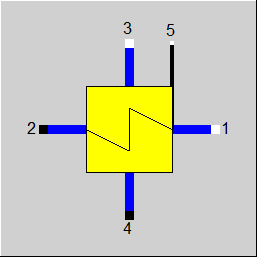 |
Display Option 1 |
 |
Display Option 2 |
 |
Display Option 3 |
 |
Display Option 4 |
 |
Display Option 5 |
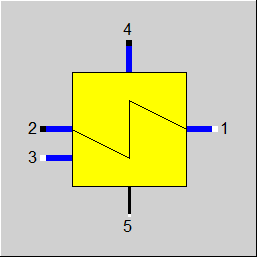 |
Display Option 6 |
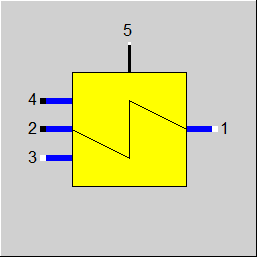 |
Display Option 7 |
 |
Display Option 8 |
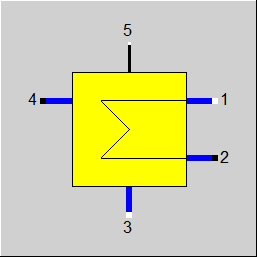 |
Display Option 9 |
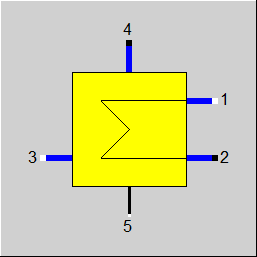 |
Display Option 10 |
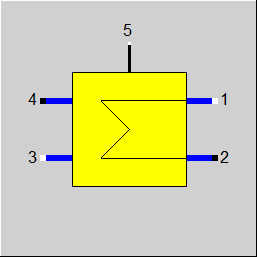 |
Display Option 11 |
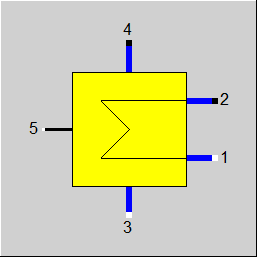 |
Display Option 12 |
 |
Display Option 13 |
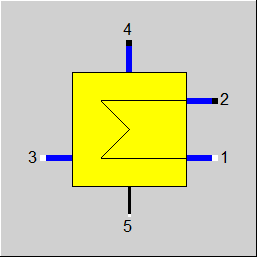 |
Display Option 14 |
 |
Display Option 15 |
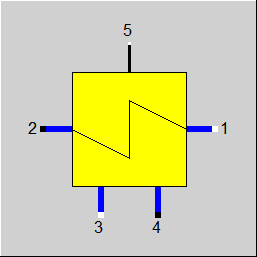 |
Display Option 16 |
Click here >> Component 27 Demo << to load an example.